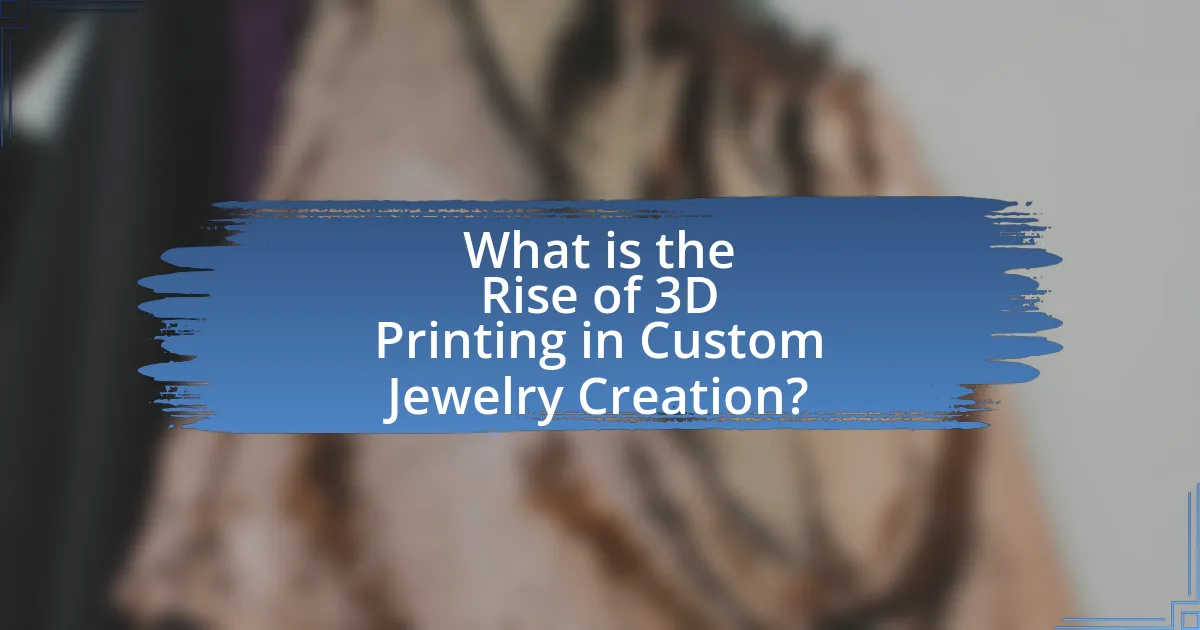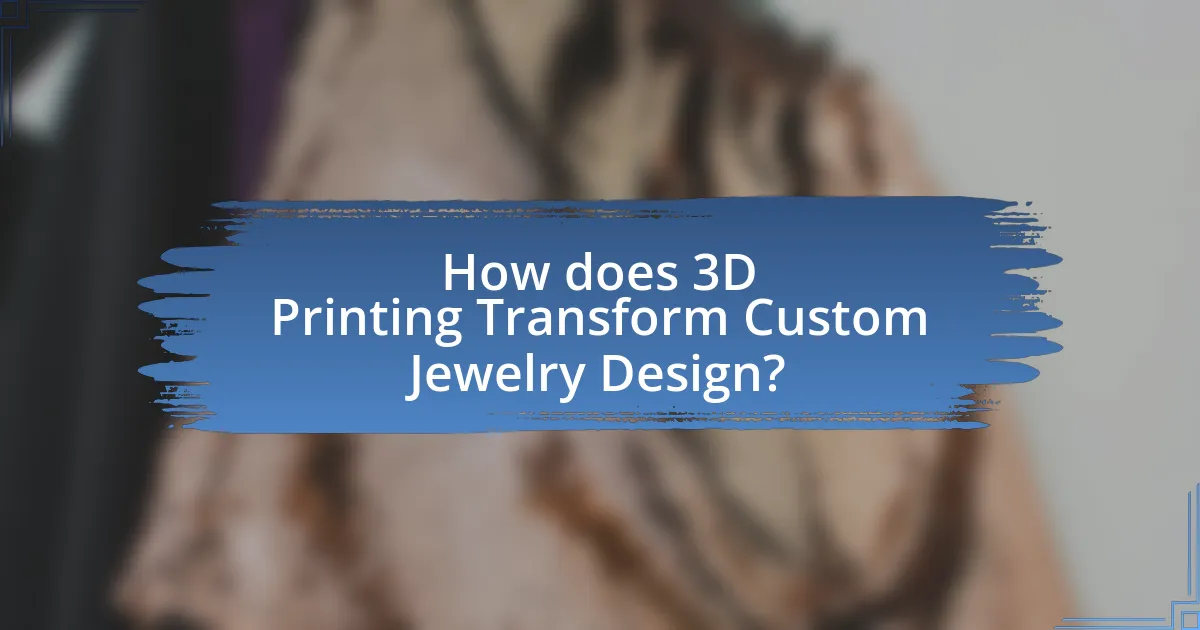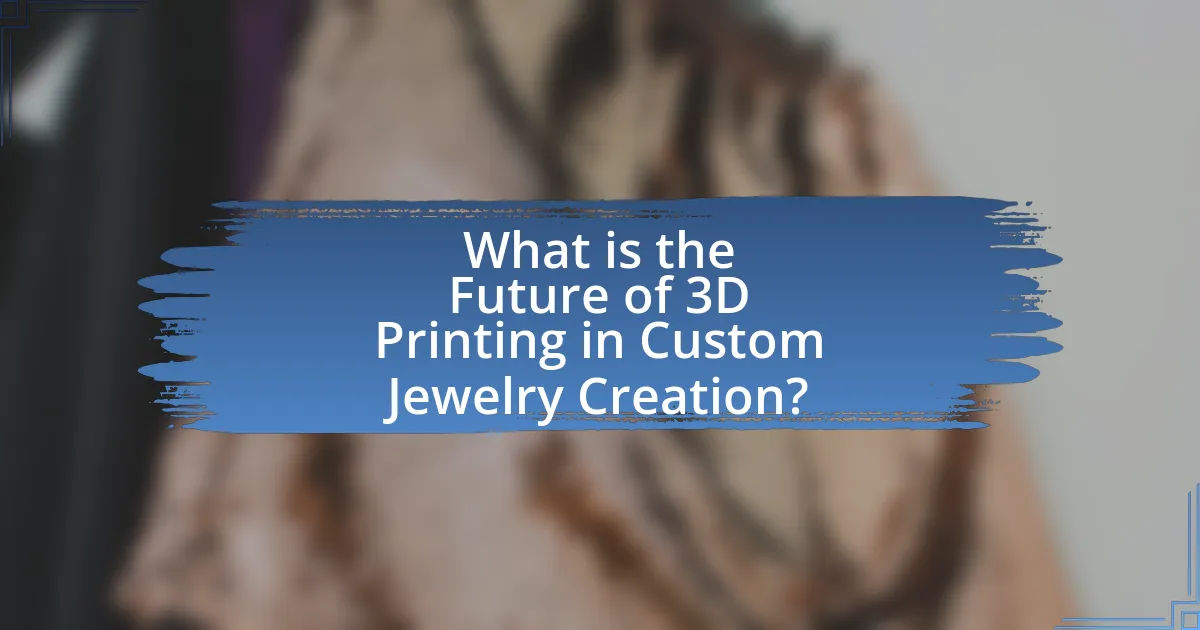The rise of 3D printing in custom jewelry creation signifies a transformative shift in the jewelry industry, characterized by the adoption of additive manufacturing technologies that enable intricate and personalized designs. This article explores the evolution of 3D printing technology, highlighting advancements such as high-resolution printers and diverse materials that enhance design flexibility and efficiency. It also addresses the impact of 3D printing on the design process, the advantages over traditional methods, and the challenges faced by traditional jewelers. Additionally, the article examines emerging trends, sustainability concerns, and best practices for jewelers adopting this innovative technology, providing a comprehensive overview of the future landscape of custom jewelry creation.

What is the Rise of 3D Printing in Custom Jewelry Creation?
The rise of 3D printing in custom jewelry creation refers to the increasing adoption of additive manufacturing technologies to design and produce unique jewelry pieces. This technology allows for intricate designs that were previously difficult or impossible to achieve with traditional methods, enabling jewelers to create personalized items tailored to individual customer preferences. According to a report by SmarTech Analysis, the 3D printing market for jewelry is projected to grow significantly, with an expected value of over $3 billion by 2025, highlighting its expanding role in the industry.
How has 3D printing technology evolved in the jewelry industry?
3D printing technology has significantly evolved in the jewelry industry by transitioning from prototyping to full-scale production. Initially, jewelers used 3D printing primarily for creating prototypes and models, allowing for rapid design iterations. Over time, advancements in materials and printing techniques have enabled the production of intricate and customizable pieces directly from digital designs. For instance, the introduction of metal 3D printing technologies, such as Direct Metal Laser Sintering (DMLS), has allowed jewelers to create complex designs in precious metals, enhancing both the quality and detail of the final products. Additionally, the accessibility of 3D printing has democratized jewelry design, enabling independent designers to produce unique pieces without the need for extensive manufacturing resources. This evolution is evidenced by the increasing number of jewelry brands adopting 3D printing as a core part of their production processes, reflecting a shift towards personalization and innovation in the industry.
What are the key advancements in 3D printing technology for jewelry?
Key advancements in 3D printing technology for jewelry include the development of high-resolution printers, the use of diverse materials, and the integration of advanced software for design customization. High-resolution printers, such as those utilizing SLA (Stereolithography) and DLP (Digital Light Processing) technologies, enable intricate designs with fine details, enhancing the aesthetic appeal of jewelry pieces. The introduction of various materials, including precious metals and biocompatible resins, allows for greater creativity and functionality in jewelry design. Additionally, advanced software tools facilitate rapid prototyping and customization, enabling designers to create unique pieces tailored to individual preferences. These advancements collectively enhance the efficiency, creativity, and personalization of jewelry production, making 3D printing a transformative force in the industry.
How do these advancements impact the design process?
Advancements in 3D printing significantly enhance the design process in custom jewelry creation by enabling rapid prototyping and intricate designs that were previously unattainable. This technology allows designers to create complex geometries and personalized pieces with high precision, reducing the time from concept to final product. For instance, 3D printing can produce detailed models in hours, compared to traditional methods that may take weeks. Additionally, the ability to easily modify designs digitally facilitates experimentation and customization, leading to innovative jewelry solutions that cater to individual preferences.
Why is 3D printing becoming popular in custom jewelry creation?
3D printing is becoming popular in custom jewelry creation due to its ability to produce intricate designs with high precision and reduced costs. This technology allows designers to create complex geometries that traditional methods cannot achieve, enabling unique and personalized pieces. Additionally, 3D printing significantly shortens the production time, allowing for rapid prototyping and quicker turnaround for customers. According to a report by Wohlers Associates, the 3D printing industry is projected to grow to $35.6 billion by 2024, indicating a strong trend towards its adoption across various sectors, including jewelry.
What advantages does 3D printing offer over traditional methods?
3D printing offers significant advantages over traditional methods, including design flexibility, reduced material waste, and faster production times. The technology allows for intricate designs that are often impossible to achieve with conventional techniques, enabling jewelers to create unique, customized pieces. Additionally, 3D printing minimizes material waste by using only the necessary amount of material for each design, contrasting with traditional methods that often involve cutting away excess material. Furthermore, production times are shortened, as 3D printers can produce items directly from digital files, eliminating the need for multiple steps involved in traditional manufacturing processes. These advantages contribute to a more efficient and innovative approach to custom jewelry creation.
How does 3D printing enhance personalization in jewelry design?
3D printing enhances personalization in jewelry design by allowing for the creation of unique, custom pieces tailored to individual preferences. This technology enables designers to produce intricate designs that can be easily modified to reflect personal styles, such as specific shapes, sizes, and engravings. For instance, a study by the Journal of Fashion Technology & Textile Engineering highlights that 3D printing reduces production costs and time, making it feasible for consumers to request bespoke designs without significant financial burden. This capability not only fosters creativity but also meets the growing demand for personalized jewelry in the market.
What challenges does the rise of 3D printing present to the jewelry industry?
The rise of 3D printing presents significant challenges to the jewelry industry, primarily through increased competition and the potential for reduced craftsmanship. Traditional jewelers face pressure from lower-cost 3D-printed alternatives, which can undermine pricing structures and market share. Additionally, the ease of replicating designs through 3D printing raises concerns about intellectual property theft, as unique designs can be easily copied and reproduced without the original creator’s consent. Furthermore, the shift towards digital fabrication may lead to a decline in traditional skills and craftsmanship, as artisans may find it difficult to compete with the speed and efficiency of 3D printing technology.
How do traditional jewelers respond to the rise of 3D printing?
Traditional jewelers are adapting to the rise of 3D printing by incorporating the technology into their design and production processes. Many jewelers utilize 3D printing to create intricate prototypes and models, allowing for greater design flexibility and efficiency. This integration enables them to offer customized pieces at a lower cost and reduced production time. For instance, a survey by the Jewelers of America found that 30% of jewelers have adopted 3D printing technology to enhance their offerings, demonstrating a significant shift in traditional practices.
What are the potential quality concerns with 3D printed jewelry?
Potential quality concerns with 3D printed jewelry include issues such as surface finish, structural integrity, and material properties. The surface finish may be rough or uneven due to the layer-by-layer printing process, which can affect the aesthetic appeal of the jewelry. Structural integrity can be compromised if the design does not account for the limitations of the printing technology, leading to fragile pieces that may break easily. Additionally, the choice of materials can impact durability; for instance, some 3D printing materials may not have the same strength or longevity as traditional metals used in jewelry making. These concerns are supported by studies indicating that the mechanical properties of 3D printed items can vary significantly based on the printing method and material used, highlighting the need for careful consideration in the design and production process.

How does 3D Printing Transform Custom Jewelry Design?
3D printing transforms custom jewelry design by enabling intricate and personalized creations that were previously difficult or impossible to achieve with traditional methods. This technology allows designers to create complex geometries and unique patterns, which can be tailored to individual preferences, enhancing the customization aspect of jewelry. For instance, a study by the Journal of Manufacturing Processes highlights that 3D printing reduces production time and costs, allowing for rapid prototyping and iteration, which fosters innovation in design. Additionally, 3D printing materials, such as resin and metal, provide durability and aesthetic versatility, further expanding the possibilities for custom jewelry.
What are the different types of 3D printing technologies used in jewelry?
The different types of 3D printing technologies used in jewelry include Stereolithography (SLA), Selective Laser Sintering (SLS), and Digital Light Processing (DLP). SLA utilizes a laser to cure liquid resin into solid objects, allowing for high precision and detail, which is essential in jewelry design. SLS employs a laser to fuse powdered materials, typically nylon or metal, creating durable pieces suitable for functional jewelry. DLP, similar to SLA, uses a digital light projector to cure resin, enabling faster production times while maintaining high resolution. Each technology offers unique advantages that cater to various aspects of jewelry creation, such as detail, material choice, and production speed.
How does each technology affect the final product?
3D printing technology significantly enhances the final product in custom jewelry creation by enabling intricate designs that are difficult or impossible to achieve with traditional methods. This technology allows for rapid prototyping, which reduces the time from concept to finished piece, and offers customization options that cater to individual preferences, such as personalized engravings or unique shapes. For instance, a study by Wohlers Associates in 2021 highlighted that 3D printing can reduce production costs by up to 90% compared to conventional manufacturing techniques, thereby allowing jewelers to offer more affordable and diverse options to consumers.
What materials are commonly used in 3D printed jewelry?
Common materials used in 3D printed jewelry include resin, metal, and plastic. Resin is often utilized for its ability to capture intricate details and is commonly used in processes like stereolithography (SLA). Metal, such as stainless steel, gold, and silver, is used in direct metal laser sintering (DMLS) for its durability and aesthetic appeal. Plastic materials, including nylon and thermoplastic polyurethane (TPU), are favored for their versatility and lightweight properties. These materials enable the creation of customized designs that are both functional and visually appealing, reflecting the advancements in 3D printing technology.
How does the design process change with 3D printing?
The design process changes significantly with 3D printing by allowing for greater complexity and customization in jewelry design. Traditional methods often limit designers to simpler forms due to constraints in manufacturing techniques, whereas 3D printing enables the creation of intricate geometries and personalized designs that were previously difficult or impossible to achieve. For instance, designers can utilize software to create detailed models that can be directly translated into physical objects, reducing the time and cost associated with prototyping. This shift not only enhances creativity but also streamlines the production process, as designs can be modified and printed on demand, minimizing waste and inventory costs.
What software tools are essential for designing 3D printed jewelry?
Essential software tools for designing 3D printed jewelry include CAD programs like Rhino, Tinkercad, and Blender. Rhino is widely used for its precision and ability to handle complex geometries, making it ideal for intricate jewelry designs. Tinkercad offers a user-friendly interface suitable for beginners, allowing for quick prototyping. Blender, known for its versatility, provides advanced modeling and rendering capabilities, which are beneficial for creating detailed visualizations of jewelry pieces. These tools collectively support the design process, enabling designers to create unique and customizable jewelry for 3D printing.
How does rapid prototyping influence design iterations?
Rapid prototyping significantly accelerates design iterations by enabling designers to quickly create and test physical models of their concepts. This process allows for immediate feedback and adjustments, which leads to more refined designs in shorter timeframes. For instance, a study by the Journal of Manufacturing Processes found that rapid prototyping can reduce the design cycle time by up to 75%, allowing for multiple iterations within a single project timeline. Consequently, designers can explore various aesthetics and functionalities, ultimately enhancing the final product’s quality and market fit.

What is the Future of 3D Printing in Custom Jewelry Creation?
The future of 3D printing in custom jewelry creation is poised for significant growth and innovation, driven by advancements in technology and materials. As of 2023, the market for 3D-printed jewelry is expanding, with projections indicating a compound annual growth rate of over 20% through the next decade. This growth is fueled by the increasing demand for personalized and unique designs, which 3D printing facilitates by allowing for intricate customization that traditional methods cannot achieve. Furthermore, the introduction of new materials, such as high-quality resins and metals, enhances the durability and aesthetic appeal of 3D-printed jewelry. Companies like Shapeways and Sculpteo are already leading the way in offering customizable options, demonstrating the viability and consumer interest in this technology.
How will consumer preferences shape the future of 3D printed jewelry?
Consumer preferences will significantly shape the future of 3D printed jewelry by driving demand for personalization, sustainability, and affordability. As consumers increasingly seek unique and customized pieces, 3D printing technology allows for intricate designs that cater to individual tastes, enabling jewelers to offer bespoke options at scale. Additionally, the growing awareness of environmental issues is pushing consumers towards sustainable practices, prompting manufacturers to utilize eco-friendly materials and processes in 3D printing. According to a report by Grand View Research, the global 3D printing market in jewelry is expected to reach $5.2 billion by 2025, reflecting the increasing consumer interest in innovative and personalized jewelry solutions. This trend indicates that as consumer preferences evolve, the 3D printed jewelry market will adapt to meet these demands, ensuring its growth and relevance in the industry.
What trends are emerging in the custom jewelry market?
Emerging trends in the custom jewelry market include the increasing adoption of 3D printing technology, which allows for greater design flexibility and personalization. This technology enables jewelers to create intricate designs that were previously difficult or impossible to achieve with traditional methods. According to a report by Grand View Research, the global 3D printing market in jewelry is expected to grow significantly, driven by consumer demand for unique and customized pieces. Additionally, sustainability is becoming a key focus, with more brands using recycled materials and eco-friendly practices in their production processes. This shift aligns with consumer preferences for ethically sourced and environmentally responsible products.
How might sustainability concerns influence 3D printing practices?
Sustainability concerns significantly influence 3D printing practices by driving the adoption of eco-friendly materials and processes. As consumers increasingly prioritize environmental responsibility, jewelry manufacturers are compelled to utilize biodegradable filaments and recycled metals in their 3D printing operations. For instance, a study by the Ellen MacArthur Foundation highlights that using recycled materials can reduce carbon emissions by up to 70% compared to traditional manufacturing methods. This shift not only aligns with consumer values but also enhances brand reputation and market competitiveness in the custom jewelry sector.
What are the best practices for jewelers adopting 3D printing?
The best practices for jewelers adopting 3D printing include investing in high-quality printers, utilizing advanced design software, and ensuring proper material selection. High-quality printers, such as those from brands like Formlabs or Stratasys, provide precision and reliability, which are crucial for intricate jewelry designs. Advanced design software, like RhinoGold or MatrixGold, allows jewelers to create detailed and customizable designs that can be easily translated into 3D models. Additionally, selecting the right materials, such as resin or metal powders, is essential for achieving the desired finish and durability in the final product. These practices enhance the overall quality and efficiency of the jewelry-making process, leading to better customer satisfaction and increased competitiveness in the market.
How can jewelers ensure quality in 3D printed pieces?
Jewelers can ensure quality in 3D printed pieces by utilizing high-resolution printers and selecting appropriate materials. High-resolution printers, such as those using SLA (Stereolithography) technology, produce finer details and smoother surfaces, which are crucial for intricate jewelry designs. Additionally, choosing high-quality materials, like durable resins or metal powders specifically designed for 3D printing, enhances the final product’s strength and appearance. Research indicates that using advanced post-processing techniques, such as polishing and plating, further improves the quality of 3D printed jewelry, ensuring it meets industry standards and customer expectations.
What strategies can jewelers use to market their 3D printed designs?
Jewelers can market their 3D printed designs by leveraging social media platforms, showcasing the unique customization options available, and collaborating with influencers. Social media allows jewelers to visually present their designs, engage with potential customers, and create targeted advertising campaigns. Highlighting the customization aspect appeals to consumers seeking personalized jewelry, as 3D printing enables intricate designs that traditional methods cannot achieve. Collaborating with influencers can expand reach and credibility, as influencers can showcase the jewelry to their followers, driving interest and sales. According to a survey by Statista, 54% of consumers use social media to research products, indicating its effectiveness in marketing.


